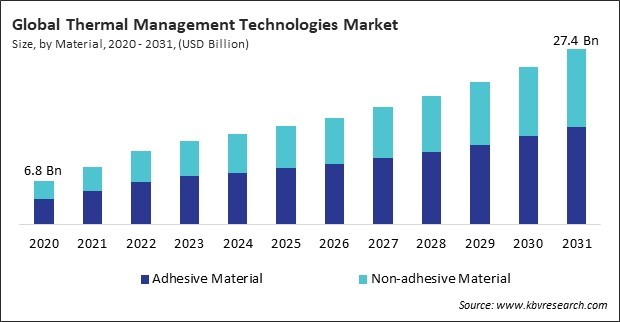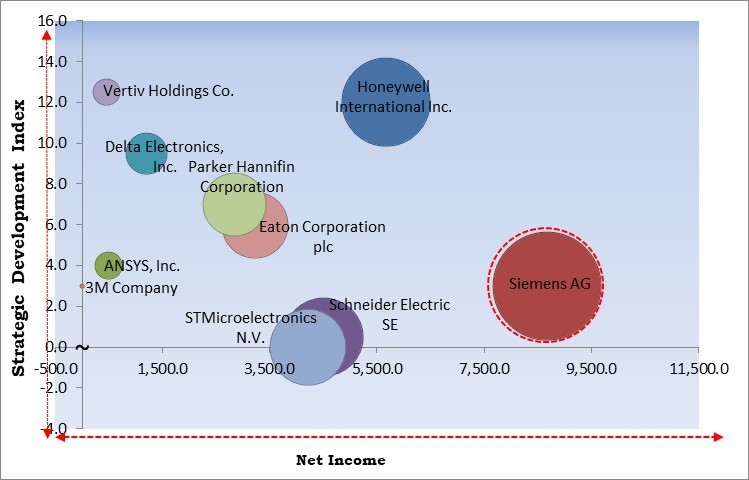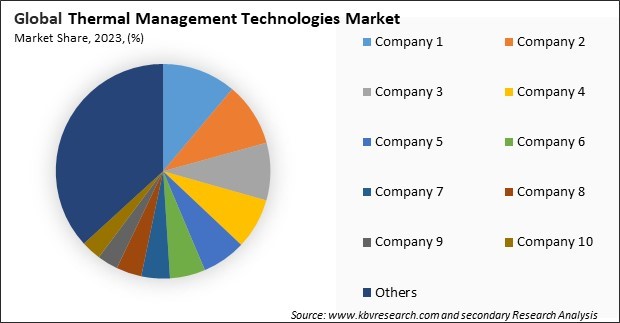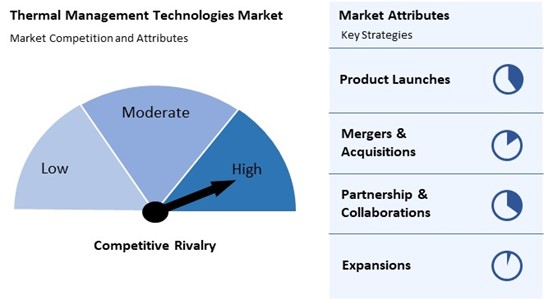“Global Thermal Management Technologies Market to reach a market value of 27.4 Billion by 2031 growing at a CAGR of 9.9%”
The Global Thermal Management Technologies Market size is expected to reach $27.4 billion by 2031, rising at a market growth of 9.9% CAGR during the forecast period.
Europe has grown strongly due to increasing investments in renewable energy systems, electric vehicles, and stringent environmental regulations promoting energy efficiency. Countries like Germany, the UK, and France are heavily investing in smart manufacturing and green technologies, which require robust thermal management solutions to ensure operational efficiency and sustainability. The Europe segment witnessed 30% revenue share in the market in 2023. The region's focus on achieving climate-neutral targets has accelerated the adoption of advanced cooling technologies, contributing to Europe's significant market share.

The major strategies followed by the market participants are Product Launches as the key developmental strategy to keep pace with the changing demands of end users. For instance, In July, 2024, Parker Hannifin Corporation unveiled the Hyperchill Plus-E, an eco-friendly industrial process chiller designed for HVAC, manufacturing, life sciences, oil and gas, and renewable energy applications. Additionally, In June, 2024, Delta Electronics, Inc. unveiled its advanced energy-efficient solutions for AI under the theme "Discovering Delta's Cloud to Edge AI." Highlights include ORV3-compliant 66kW and 33kW server power shelves with up to 97.5% efficiency and innovative vertical power delivery for AI accelerators.
Based on the Analysis presented in the KBV Cardinal matrix; Siemens AG is the forerunner in the Thermal Management Technologies Market. In June, 2024, Siemens AG unveiled Calibre 3D Thermal software for advanced thermal analysis of 3D integrated circuits (ICs). This tool addresses the EDA gap for 3D ICs, which stack silicon layers to boost performance and minimize footprint. Companies such as Honeywell International Inc., Eaton Corporation plc, and Parker Hannifin Corporation are some of the key innovators in Thermal Management Technologies Market.

With the rapid evolution of technology, devices such as smartphones, laptops, tablets, and wearable devices are becoming increasingly powerful. As processing power and functionality increase, these devices generate more heat during operation. For instance, modern smartphones and laptops' high-performance processors and GPUs can run complex applications, including gaming, video editing, and AI-based tasks, which generate significant heat. Hence, it is anticipated that the demand for compact and efficient thermal management solutions will increase as consumer electronics continue to dominate markets.
Industries such as aerospace, defense, and healthcare have been revolutionized by advancements in the miniaturization of electronic components, which have enabled the development of more compact and efficient devices. However, as components shrink, they generate more heat in a smaller area, increasing the thermal management challenge. Similarly, in consumer electronics, Apple has adopted graphene-based heat spreaders in its iPhone 13 to dissipate heat from its internal components, ensuring optimal performance without compromising on the device’s slim design. Thus, advancements in miniaturization are significantly aiding in the expansion of the market.
Many thermal management technologies depend on specialized materials like phase-change materials (PCMs), graphene, and advanced heat sinks, offering superior thermal conductivity and heat dissipation properties. However, the production and procurement of these materials are costly, especially compared to traditional alternatives like aluminum or copper. For instance, phase-change materials, which can absorb and release large amounts of latent heat, are highly effective in managing temperature spikes. Thus, the high cost of thermal management technologies presents a significant challenge to widespread adoption.

The leading players in the market are competing with diverse innovative offerings to remain competitive in the market. The above illustration shows the percentage of revenue shared by some of the leading companies in the market. The leading players of the market are adopting various strategies in order to cater demand coming from the different industries. The key developmental strategies in the market are Product Launches and Product Expansions.
Based on material, the market is bifurcated into adhesive material and non-adhesive material. The non-adhesive material segment procured 42% revenue share in the market in 2023. Non-adhesive materials, including heat sinks, liquid cooling systems, and thermal interface materials (TIMs), are crucial for managing heat in larger applications such as industrial machinery, data centers, and electric vehicles. These materials are vital for environments that require high thermal conductivity and durable performance without adhesive properties.
On the basis of device, the market is classified into conduction cooling device, convection cooling device, advanced cooling device, and others. The conduction cooling device segment acquired 42% revenue share in the market in 2023. This can be attributed to the widespread use of conduction cooling systems in various applications, where direct heat transfer through solid materials is efficient and cost-effective.

By service, the market is divided into installation & calibration and optimization & post sales service. The optimization & post sales service segment garnered 42% revenue share in the market in 2023. This segment focuses on the ongoing maintenance, performance optimization, and after-sales support of thermal management systems to ensure they function efficiently. As industries strive to extend the lifespan of their equipment and reduce operational costs, there has been a growing demand for services that optimize cooling systems over time.
Based on end-use, the market is segmented into consumer electronics, service & data centers, automotive, healthcare, and others. The consumer electronics segment procured 41% revenue share in the market in 2023. The growing demand for effective thermal management solutions in devices such as smartphones, laptops, tablets, and wearable technologies is the primary factor driving the segment's expansion. The management of heat has become increasingly important in order to ensure the longevity, performance, and battery life of electronic devices as they become more compact and potent.
Free Valuable Insights: Global Thermal Management Technologies Market size to reach USD 27.4 Billion by 2031
Region-wise, the market is analyzed across North America, Europe, Asia Pacific, and LAMEA. The North America segment recorded 36% revenue share in the market in 2023. In the United States and Canada, the region's dominance is primarily due to the pervasive adoption of advanced technologies in sectors such as data centers, electric vehicles, and consumer electronics. The demand for thermal management solutions has been significantly bolstered by the increase in industrial automation and high-performance computing, as well as the strong presence of leading market participants.

The thermal management technologies market is highly competitive, driven by increasing demand across industries like electronics, automotive, and aerospace. Key factors include the need for efficient cooling solutions as devices become smaller and more powerful, especially in data centers, electric vehicles, and 5G infrastructure. Major players focus on innovations in heat sinks, liquid cooling, and phase-change materials to gain a competitive edge and meet rising performance standards.
| Report Attribute | Details |
|---|---|
| Market size value in 2023 | USD 13.1 Billion |
| Market size forecast in 2031 | USD 27.4 Billion |
| Base Year | 2023 |
| Historical Period | 2020 to 2022 |
| Forecast Period | 2024 to 2031 |
| Revenue Growth Rate | CAGR of 9.9% from 2024 to 2031 |
| Number of Pages | 314 |
| Tables | 454 |
| Report coverage | Market Trends, Revenue Estimation and Forecast, Segmentation Analysis, Regional and Country Breakdown, Competitive Landscape, Market Share Analysis, Porter’s 5 Forces Analysis, Company Profiling, Companies Strategic Developments, SWOT Analysis, Winning Imperatives |
| Segments covered | Service, End Use, Material, Device, Region |
| Country scope |
|
| Companies Included | Schneider Electric SE, Delta Electronics, Inc., Honeywell International Inc., Siemens AG, STMicroelectronics N.V., 3M Company, Vertiv Holdings Co., Eaton Corporation plc, ANSYS, Inc., Parker Hannifin Corporation |
By Material
By Device
By Service
By End-use
By Geography
This Market size is expected to reach $27.4 billion by 2031.
Rising Demand for Consumer Electronics are driving the Market in coming years, however, Design Complexity and Integration Challenges restraints the growth of the Market.
Schneider Electric SE, Delta Electronics, Inc., Honeywell International Inc., Siemens AG, STMicroelectronics N.V., 3M Company, Vertiv Holdings Co., Eaton Corporation plc, ANSYS, Inc., Parker Hannifin Corporation
The expected CAGR of this Market is 9.9% from 2024 to 2031.
The Installation & Calibration segment is leading the dominated the Market by Service in 2023; thereby, achieving a market value of $15.3 billion by 2031.
The North America market dominated the Market by Region in 2023; thereby, achieving a market value of $9.5 billion by 2031.
Our team of dedicated experts can provide you with attractive expansion opportunities for your business.

 Drivers
Drivers
 Restraints
Restraints
 Opportunities
Opportunities
 Challenges
Challenges
